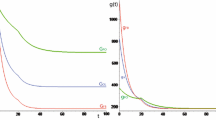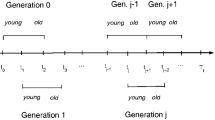Abstract
We study the exploitation of a common groundwater resource, first as a static and then as a differential game, in order to take into account the strategic and dynamic interactions among the users of the resource. We suppose that firms can form coalitions or can decide not to cooperate. The non-cooperation regime is characterized by pumping that lead to depletion of the aquifer; the cooperation preserves the resource. Open-loop and feedback equilibria have been computed and compared in order to characterize the existence of cooperators and defectors in water resources management.
Similar content being viewed by others
References
Brown, G.: Renewable natural resource management and use without markets. J. Econ. Lit. 38(4), 875–914 (2000)
Burke, J.: Groundwater for irrigation: productivity gains and the need to manage hydro-environmental risk. In: Llamas, M.R., Custodio, E. (eds.) Intensive Use of Groundwater: Challenges and Opportunities, Chapter 3, pp. 59–80. Taylor and Francis, London (2003)
Esteban, E., Albiac, J.: Groundwater and ecosystems damages: questioning the Gisser–Sanchez effect. Ecol. Econ. 70, 2062–2069 (2011)
Gisser, M., Sanchez, D.: Competition versus optimal control in groundwater pumping. Water Resour. Res. 16, 638–642 (1980)
Jaroslav, V., Annukka, L.: Groundwater resources sustainability indicators. IHP-VI Series on Groundwater 14 (2007)
Koundouri, P.: Current issues in the economics of groundwater resource management. J. Econ. Surv. 18(5), 703–740 (2004)
Koundouri, P., Xepapadeas, A.: Estimating accounting price for common pool natural resources: a distance function approach. Water Resour. Res. 40(6), S617 (2004)
Negri, D.: The common property aquifer as a differential game. Water Resour. Res. 25, 9–15 (1989)
Provencher, B., Burt, O.: The externalities associated with the common property exploitation of groundwater. J. Environ. Econ. Manag. 24, 139–158 (1993)
Rubio, S.J., Casino, B.: Competitive versus efficient extraction of a common property resource. The groundwater case. J. Econ. Dyn. Control 25, 1117–11137 (2001)
Rubio, S.J., Casino, B.: Strategic behavior and efficiency in the common property extraction of groundwater. Environ. Resour. Econ. 26, 73–87 (2003)
Author information
Authors and Affiliations
Corresponding author
Appendix
Appendix
Proof of Proposition 2
In order to solve the problem proposed, we use the maximum principle. Let us define the current value of the Hamiltonian \(\mathcal {H}\) in the standard way.
where \(\lambda _i\) and \(\lambda _j\) are the adjoint variables. We obtain the following set of necessary conditions for an interior open-loop equilibrium:
which give us:
The adjoint equations are:
and the transversality conditions being:
Taking into account that, at the steady state, \(\dot{H}=\dot{\lambda } =0\), the first-order conditions and the adjoint equations are used to determine the stationary equilibrium
and moreover
From differential equation, we have
By substitution of \(\lambda _i\) and \(\lambda _j\), we obtain the steady-state value of water table
where
and so
and
\(\square \)
Proof of Proposition 3
We have
\(\square \)
Rights and permissions
About this article
Cite this article
Biancardi, M., Maddalena, L. Competition and cooperation in the exploitation of the groundwater resource. Decisions Econ Finan 41, 219–237 (2018). https://doi.org/10.1007/s10203-018-0217-0
Received:
Accepted:
Published:
Issue Date:
DOI: https://doi.org/10.1007/s10203-018-0217-0




